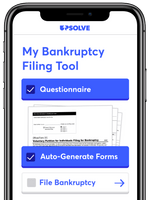Consolidating Federal Student Loans: A Comprehensive Guide
Upsolve is a nonprofit that helps you eliminate your debt with our free bankruptcy filing tool. Think TurboTax for bankruptcy. You could be debt-free in as little as 4 months. Featured in Forbes 4x and funded by institutions like Harvard University — so we’ll never ask you for a credit card. See if you qualify
If you’re like most students, you’ll take out multiple student loans throughout your college career. When repayment begins, you may find yourself juggling multiple loan payments, due dates, and interest rates each month. Consolidating your student loans can streamline the repayment process, and it may even save you money. The U.S. Department of Education currently offers one kind of consolidation loan called a Federal Direct Consolidation Loan. Here’s what you need to know to make informed decisions about consolidation.
Written by the Upsolve Team. Legally reviewed by Attorney Andrea Wimmer
Updated June 5, 2023
Table of Contents
What Is Student Loan Consolidation?
When you consolidate student loans, you combine two or more loans into a single loan. This simplifies the repayment process — you only need to make one payment a month. But it may also extend the term of the loan repayment (the number of years you have to repay the loan). This has two outcomes, one positive and one negative:
On the upside, your monthly payment may be lower.
On the downside, you’ll end up paying more over the life of the loan if you only make the minimum monthly payment.
What Student Loans Can Be Consolidated?
Many types of loans can be consolidated with a Direct Consolidation Loan. For example, you can consolidate any of the following federal student loans:
Direct Loans (subsidized or unsubsidized)
Direct PLUS Loans
Federal Stafford Loans (subsidized or unsubsidized)
Federal Perkins Loans
PLUS Loans under the FFEL program
One federal loan that can’t be consolidated is a Direct PLUS Loan a parent took out to help pay for their child’s education.
Can You Consolidate Private Student Loans?
No. The Direct Consolidation Loan Program is a federal program targeted at helping borrowers with student loans that were issued or backed by the Department of Education. Private student loans are loans that are issued and backed by private lenders.
You may be able to refinance your private student loan(s), but you can’t use the federal loan consolidation program. If you have a mix of private and federal student loans, you could refinance your loans to combine them all into one loan, but doing so turns your loans into private loans. This means you lose access to federal programs and benefits like income-driven repayment (IDR) plans and student loan forgiveness.
What Are the Pros and Cons of Federal Student Loan Consolidation?
Consolidating your federal student loans has many upsides, but it’s important to understand potential consequences as well. Let’s look at the pros and cons of loan consolidation.
The Benefits of Consolidating Your Student Loans
Consolidating your loans makes it easier to manage repayment. This is especially true if you have more than one loan servicer. You’ll shift from multiple monthly payments and due dates to a single payment and due date. And you’ll be dealing with a single loan servicer — that’s the company that manages your loan.
Working with a single servicer can be especially helpful if:
You need to request deferment or forbearance to temporarily pause your loan payments
You want to enroll in an income-based repayment plan to help reduce your monthly payments
You participate in a student loan forgiveness program
If you have multiple loans with different servicers, these processes can be much more complicated.
Consolidation also extends your repayment timeline, which usually means lower monthly payments. And you may gain access to options like income-driven repayment plans and Public Service Loan Forgiveness (PSLF) when you consolidate loans other than Direct Loans. Note, though, that not all consolidated Direct Loan payments count as qualifying payments for PSLF purposes. Make sure you choose a repayment structure that will give you credit for all of your loan payments. To learn more, read our Guide To Public Service Loan Forgiveness.
When you consolidate your loans, your interest rate will be the weighted average of all your current loans. You’ll get a fixed interest rate for the consolidation loan. Because the new interest rate reflects the weighted average of your existing loans, it’ll be a lower rate than some loans but higher than others.
The Drawbacks of Student Loan Consolidation
Probably the biggest drawback to consolidating your student loans is that you’ll be on a longer repayment timeline. While this lowers your monthly payment, it means interest has more years to accumulate. Therefore, the total cost of your loan is higher in the long run.
This may not be an issue if you can afford to pay more than the required minimum monthly payment. The faster you pay back the principal of your loans, the less you pay in interest over time.
Another red flag for some borrowers is that they may lose repayment options. It’s important to make sure you understand how each specific loan will be impacted by consolidation. For example, if you have a Perkins Loan, you may be eligible for loan cancellation under certain circumstances. But you’ll lose that eligibility if you consolidate your Perkins Loan into a Direct Loan.
How To Consolidate Your Federal Student Loans
You can complete a Direct Consolidation Loan application online or print out the application and mail it in. To fill out the application, you’ll need details about your existing loans. If you don’t have the information you need, you can get it from the National Student Loan Data System run by StudentAid.gov. You can also call the Federal Student Aid Information Center (FSAIC) at 1-800-433-3243.
If you have questions about consolidation before you apply, you can call the Student Loan Support Center at 1-800-557-7392.
Step-by-Step Guide To Student Loan Consolidation
There are five basics steps to consolidating your student loans.
Determine which eligible loans you want to include in the consolidation.
Provide detailed information about those loans on your application.
Choose standard repayment or an income-driven repayment plan.
If you choose an income-driven plan, complete the appropriate request form.
Make sure to read and understand the terms before submitting the application.
If you have questions after you apply, you’ll need to contact your new servicer. Make sure you take note of its contact information when you complete your application. After you submit your application, keep making the payments on your original loans until the consolidation process is complete.
Student Loan Consolidation FAQS
Have questions? We may have an answer for you below.
Can You Consolidate Student Loans That Are in Default?
If your loan is in default, you’ll have to take additional steps before applying for consolidation. You must either “agree to repay the new Direct Consolidation Loan under an IDR plan, or make three consecutive, voluntary, on-time, full monthly payments on the defaulted loan before you consolidate it,” according to StudentAid.gov.
When Should You Consolidate Your Federal Student Loans?
It’s common to consolidate loans shortly after leaving school but before repayment begins. To consolidate, your loans must be either in the grace period or in repayment. The grace period varies depending on the terms of the loan but typically begins when you leave school or drop below part-time hours. The grace period for most federal education loans is six months.
How Often Can You Consolidate Student Loans?
You can only consolidate eligible loans one time. But you may be able to consolidate again if you take out additional eligible loans. For example, if you consolidate your loans when you graduate from college but later return to school for a graduate degree, you can apply for a consolidation loan that combines your previous consolidation loan with the new loans you took out for graduate school.
Does Loan Consolidation Affect Public Service Loan Forgiveness?
Timing is especially important if you are working toward PSLF. Loan forgiveness under PSLF requires making 10 years of qualifying payments before the remaining loan balance is forgiven. Direct Consolidation Loans are eligible for PSLF. But if you’re already making qualifying payments, consolidation will cut off that process. You’ll lose credit for any qualifying payments you made on your old student loans and must begin the 10-year repayment period again. Depending on where in the process you are, that reset could be very expensive and could delay loan forgiveness for years.
The bottom line? Timing counts. It’s important to gather information and carefully consider your options before committing to a plan of action.
Is Student Loan Consolidation the Same as Refinancing?
No. Refinancing means you repay one or more existing student loans by getting a new loan, typically from a private lender. The new loan pays off the old loans and you’re left with a single loan with new terms and conditions. You can refinance private student loans, federal student loans, or a combination. (Though there are consequences, which we’ll cover below.)
Consolidation is similar in that it allows you to combine multiple loans into a simple loan, but consolidation is only for federal student loans.
Some lenders may advertise student loan refinancing as a “private consolidation loan,” but this is misleading. There are very important differences between refinancing and consolidation. Namely, when you refinance a federal student loan, you lose access to certain protections and programs specific to federal student loans, such as:
The right to request a deferment or forbearance if you are having trouble making payments
Access to income-driven repayment options
Eligibility for certain loan forgiveness programs
How Does Student Loan Refinancing Work?
You refinance student loans through a private lender like a bank. When you refinance your loans, you essentially take out a new loan. To determine your eligibility, the lender will run a credit check and verify your income. Depending on your credit score, your income, and other factors, the lender will decide whether to lend you money and what interest rate to offer you (this may be a fixed or variable interest rate; federal loans often have lower interest rates than private loans).
If your credit is bad or you have little or no credit history, the lender may deny your application or require a cosigner. A cosigner is another person with more established credit who takes on joint responsibility for repayment of the loan.
With a private lender, your loan terms and interest rate will depend on many factors, such as:
The lender
Your credit history
The loan amount
The repayment term
The new loan is just like any other loan you’d take out from a private lender.
Refinancing with a private lender does have a couple of advantages. You can refinance private education loans that aren’t eligible for federal student loan consolidation. And, if you default on a private loan, lenders and servicers have to work a little harder to collect from you. They can’t jump straight to garnishing your wages or taking your tax refund like the U.S. Department of Education can.













